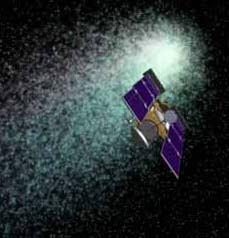1 July 1998
Stardust Spacecraft Set to Retrieve Comet Samples
 When the Stardust spacecraft (pictured) blasts off from Cape Canaveral next February, a University of Washington astronomy professor's long-standing dream will have come to fruition. Donald Brownlee had his brain wave back in 1980, after the comet Wild 2 altered its course during a close encounter with Jupiter. He proposed sending a craft to fetch back some samples, taking advantage of the comet's new orbit among the inner planets. At the time the idea was deemed unrealistic. Eighteen years later, the first unmanned spacecraft to return samples of space material to Earth for analysis is all systems go.
When the Stardust spacecraft (pictured) blasts off from Cape Canaveral next February, a University of Washington astronomy professor's long-standing dream will have come to fruition. Donald Brownlee had his brain wave back in 1980, after the comet Wild 2 altered its course during a close encounter with Jupiter. He proposed sending a craft to fetch back some samples, taking advantage of the comet's new orbit among the inner planets. At the time the idea was deemed unrealistic. Eighteen years later, the first unmanned spacecraft to return samples of space material to Earth for analysis is all systems go.
"We hope to understand how comets were formed and what they're made of," says Brownlee. "We expect them to be the preserved building blocks of the outer planets."
The fourth mission in Nasa's Discovery series, Stardust will undergo a 7-year, 3.1-billion-mile journey powered by solar panels, meeting up with Wild 2 in January 2004. Passing about 75 miles from the body of the comet, the craft will trap small particles from its coma while simultaneously transmitting the first-ever close-up comet pictures back to Earth. Stardust will then return home, crashing down into Utah's Great Salt Desert in January 2006. (See timeline below.)
Brownlee named the spacecraft himself, after Hoagy Carmichael's popular tune (later recorded by Willie Nelson and Ringo Starr): "I liked it because most spacecraft missions had weird, bizarre names. They were acronyms for something," he says. "This isn't an acronym for anything. It's just a name people know."
Meanwhile, hundreds of thousands of punters are looking to get a vicarious thrill by having their names inscribed on a microchip aboard the Stardust payload. Any aliens intent on reading the names will have to have pretty good eyesight, as the writing is so small that 80 letters will fit into the width of a human hair, and the microchip itself is but the size of a fingernail. Even so, over 300,000 people have already signed up.
STARDUST MISSION TIMELINE
1929: Hoagy Carmichael writes the song "Stardust".
1974: Close encounter with Jupiter causes major orbital shift for comet Wild 2.
1978: Wild 2 discovered by Swiss astrophysicist Paul Wild on January 6 during its first close approach to Earth.
1980: Astronomer Donald Brownlee dreams up the concept behind the current Stardust mission.
1995: Nasa selects Stardust mission to retrieve samples from Wild 2.
1999: Launch of Stardust spacecraft scheduled for February 6.
2000: January 15, Stardust passes near Earth to get a gravitational speed boost.
2002: July through December, interstellar dust collection.
2004: January 2, encounter with Wild 2; spacecraft will fly through comet's coma, take pictures and collect dust samples.
2006: January 15, spacecraft returns to Earth; capsule containing comet samples dropped by parachute to the Utah Test Training Range; speed of 13 kilometres per second is the fastest for any re-entry vehicle.
Picture courtesy of NASA/JPL/Caltech
